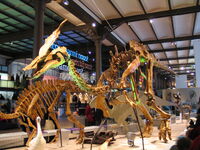Olorotitan was a genus of lambeosaurine duckbilled dinosaur from the middle or latest Maastrichtian-age Late Cretaceous[1] Tsagayan Formation beds located in Kundur, Amur Region, Far Eastern Russia. There's only one species, Olorotitan arharensi whose holotype specimen, consisting of a nearly complete skeleton, was described by Pascal Godefroit et al. in mid-2003. The generic name Olorotitan means “gigantic swan” while the specific descriptor arharensis refers to the location of the fossil find at Arhara County. Olorotitan is distinct from other crested duckbills by its possession of an unusual crest that points backward and takes on a hatchet or fan-like shape. Its discovery has implications for the diversity of lambeosaurine hadrosaurids.
Description[]
Olorotitan arharensis is based on the most complete lambeosaurine skeleton found outside North America to date. It was a large hadrosaurid, comparable to other large lambeosaurines like Parasaurolophus cyrtocristatus,[2] and may have grown up to 12 meters long (39 ft).[3][verification needed] It is characterized by numerous unique features for a hadrosaurid, the most obvious being the large hatchet-like hollow crest adorning its skull. The skull itself is supported by a rather elongated neck, having 18 vertebrae, exceeding the previous hadrosaurid maximum of 15. The sacrum, with 15 or 16 vertebrae, has at least 3 more vertebrae than other hadrosaurids. Further along the vertebral series, in the proximal third of the tail, there are articulations between the tips of the neural spines, making that caudal area particularly rigid; the regularity of these connections suggests that they are not due to a pathology, although more specimens are needed to be certain. Godefroit and his coauthors found through a phylogenetic analysis that it was closest to Corythosaurus and Hypacrosaurus.
Paleoecology and paleobiology[]
O. arharensis shared its time and place with several other types of animal, including two other lambeosaurines: the Parasaurolophus-like Charonosaurus and more basal Amurosaurus. Additionally, remains from turtles, crocodilians, theropods, and nodosaurids were found at its discovery site,[2] and the Saurolophus-like hadrosaurine Kerberosaurus is also known from roughly contemporaneous rocks in the area.[4] Unlike the situation in North America, where lambeosaurines are essentially absent from Late Maastrichtian rocks, Asian lambeosaurines are diverse and common at the end of the Mesozoic, suggesting climatic or ecological differences.[2]
As a hadrosaurid, Olorotitan would have been a bipedal/quadrupedal herbivore, eating plants with a sophisticated skull that permitted a grinding motion analogous to chewing, and was furnished with hundreds of continually-replaced teeth. Its tall, broad hollow crest, formed out of expanded skull bones containing the nasal passages, probably functioned in identification by sight and sound.

